2. INHERITANCE OF FASCIATIONS AMONG CACTI
IGOR SKULKIN, Ph. D
for the beginning Cultivar issue 4(5), article
"The role of inherited fasciations in the forming of cacti"
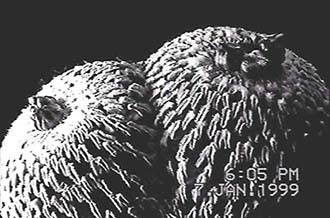 |
| Photo 1. |
We have already mentioned that different groups of plants are capable of inheriting fasciations. Since fasciations can "be propagated by seeds, stem, leaf and root cuttings one can single out inherited variants of fasciations through selection and it has been shown for a number of cultivated plants" (Zhukovsky, 1950).
Some experts doubt this possibility. They believe crested forms of cacti have never been reproduced by seeds (Sharli, 1959). Bowk and Ross (1978) who studied fasciations of Echinocereus reichenbachii had no seeds of fasciated plants and could not be definite about the inheritance of fasciations.
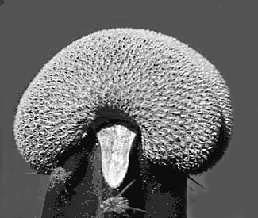 |
| Photo 2. |
As it is said in the review by Sneider and Weber (1966) the case of inheritance of crested form in cacti was first established for Chamaecereus silvestrii v. crassicaulis grown from seeds. The seeds of crested Echinopsis multiplex gave 3% of crested seedlings. Shuts (1977) says about blooming of crested Gymnocalycium michanovichi that bore fruit without artificial pollination. The seeds had good germinating capacity and gave more than 50% of crested seedlings. The seeds gathered from crested Rebutia minuscula had excellent germinating capacity and gave 100% of seedlings with different degree of fasciation. There were 40% of crests and the rest were multi-headed or monstrose forms. Fasciations appeared on the 4th or 5th month, not simultaneously but within a short time period. No changes in the environment preceded their appearance.
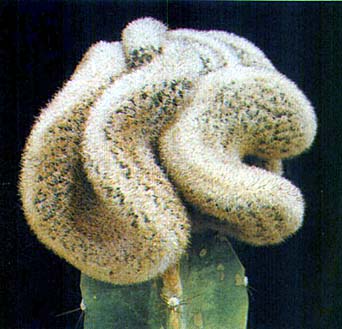 |
| Photo 3. |
Fasciation (cristation in particular) is a change of the very apical meristem and its closest derivatives not affecting underlying differentiated tissues and organs. When decapitation (full removal of cristate meristem) takes place offsets developing from the lateral areoles will "always be normal" (Bowk, Ross, 1978). However in the case of inherited fasciation in Rebutia minuscula observed by the author the removal of linear meristem of the seedling led to appearance of fasciated offsets from the lateral areoles. It should be mentioned that be vegetative reproduction of the crest the fasciation didn't appear right away but only when the offset was about 1 cm in diameter.
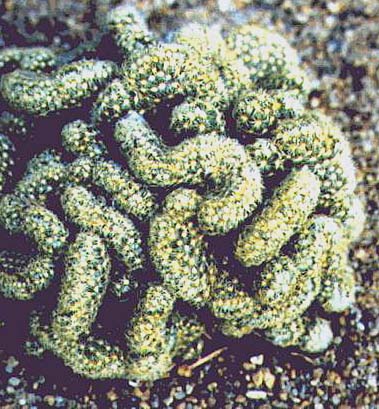 |
| Photo 4. |
Coexistence of two types of fasciation – inherited and non-inherited – is quite possible even among the same species. If fasciation is inherited it may be propagated both by seeds and by lateral offsets after the full decapitation of the crest.
Besides if fasciation can be fixed through selection the similar process might have taken place in the nature.
 |
| Photo 5. |
CONCLUSIONS
Fasciations in cacti embrace a number of different changes in the normal course of morphogenesis in meristems. Fasciations can be caused by somatic mutations and sudden changes of environmental conditions. There are non-inherited and inherited fasciations. The latter are more frequent with cacti than it is generally believed. Inherited fasciations reproduced by seeds can also be propagated in vegetative way, that is by lateral offsets from lower areoles. Fasciations can cause dramatic changes in the whole plant, not only near the fasciated meristem. One can suppose that the mechanism of changes is conditioned by the failures in the normal balance of phytohormones.
Any cacti meristems can fasciate, not only apical ones. It is proved by cases of axillary fasciations and roots cristation. Fixation of fasciations in the course of natural selection could lead to the development of flat segments of Opuntia, elongated and dimorphic areoles, flattened spines and cephaliums of different types.
Since types of fasciations are very numerous and their causes are as a rule unknown it is necessary to examine them in every particular case paying special attention to phytohormones balance, comparative anatomy of fasciated and normal plants and the inheritance mechanism of the fasciation. In general we should consider fasciation not just as an accidental teratological change, but also as a way of developing absolutely new structures in the evolution of plants.
Appendix
CLASSIFICATION OF CACTI FASCIATIONS
А) BY THE CHARACTER OF FASCIATION
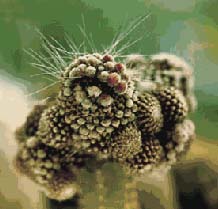 |
| Photo 6. |
I. Polytomy (multi-headedness).
1.1. Inherited dichotomy.
1.2.Non-inherited polytomy. (Photo 1)
II. Cristation.
II.1. True cristation (linear meristem).
II.1.1. Fan shaped (Photo 2)
II.1.2. Wavy (Photo 3)
II.1.3. Brain shaped (Photo 4)
II.2. Plural dichotomy.
II.2.1. Fan shaped.
II.2.2. Wavy.
II.2.3. Brain shaped.
III. Monstrousness.
III.1. True monstrousness (generative organs are not formed or formed very late) (Photo 5)
III.2. Micro monstrousness (dwarf size, continuous formation of underdeveloped buds) (Photo 6)
B) BY LOCALIZATION OF FASCIATION
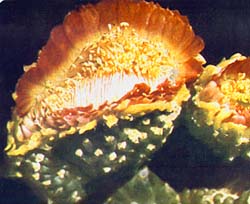 |
| Photo 7. |
I. Root fasciation.
II. Stem fasciation.
II.1. Apical meristem fasciation.
II.2. Areola meristem fasciation.
II.2.1. Common areola meristem fasciation.
II.2.2. Fasciation of intercalary meristems of spines.
II.2.3. Axillary fasciations.
III. Flower fasciation (Photo 7)
IV. Fruit fasciation (not found among cacti).
V. Seed germ fasciation.





